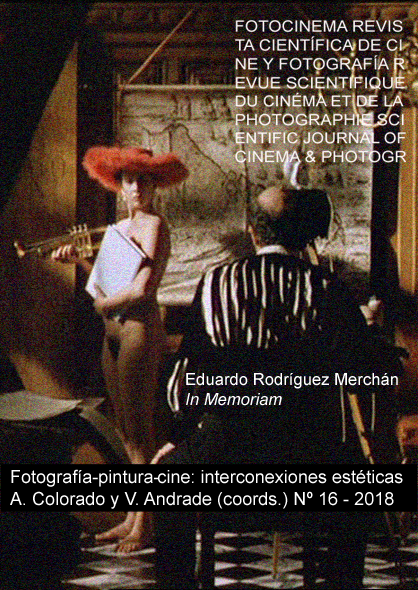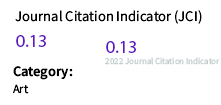Framing and deframing: Space and significance in Ida
DOI:
https://doi.org/10.24310/Fotocinema.2018.v0i16.4094Keywords:
Framing, Deframing, Frame, Cinematography, IdaAbstract
The importance of composition in the cinematographic fact as a foundational and fundamental element can be better understood knowing the difference between types of composition. This inheritance of the photographic apparatus shows that the rupture of the institutional composition rises to different compositional options that break with the importance of the center, showing the possibility of enlargement of the image's meaning related to the elements that its creators choose when composing it. This is the case of Pawel Pawlikowski’s Ida (2013), whose cinematography and composition work adds meaning to each one of the images individually and in the whole of the film thanks to the chosen look marked by his photographic referents.
With the objective of showing these aspects this article analyses the film with concepts related to figurative, reflexive and aleatory composition. These concepts are reunited in a definition of what's been articulated as deframing.
Downloads
Metrics
Publication Facts
Reviewer profiles N/A
Author statements
Indexed in
-
—
- Academic society
- N/A
- Publisher
- Universidad de Málaga
References
Abela, J. A. (2003). Las técnicas de Análisis de Contenido: una revisión actualizada. Centro de estudios andaluces. https://goo.gl/tX6JHb
Abraham, E., Dzieciol, P., Puszczynska, E. (Productores), & Pawlikowski, P. (Director). (2013). Ida [Película]. Polonia, Dinamarca, Italia: Opus Film, Phoenix Film, Portobello Pictures.
Albero, E. (2014). Contemplativo y atemporal. Caimán. Cuadernos de Cine. Vol. 25(76), 45.
Arnheim, R. (1982). The power of the center. A study of Composition in the Visual Arts. Londres: University of California Press.
Aumont, J. (1992). La imagen. Barcelona: Paidós Comunicación.
Bergery, B. (2014). Divine purpose. American Cinematographer, Vol. 95(5), 54-63.
Bonitzer, P. (orig. 1978). Décadrages. Cahiers du Cinéma, Vol. 284. En Wilson, D. (ed.) (2000), Cahiers du Cinéma, Volume Four, 1973-1978: History, Ideology, Cultural Struggle (pp. 197-203). Londres: Routledge.
Brown, B. (2012). Cinematography. Theory and Practice (2nd Edition). Oxford: Focal Press.
Burch, N. (1970). Praxis du cinéma. París: Gallimard.
De Pablos, J. (2005). La pintura y su influencia en el cine. Una aproximación pedagógica a la obra de Edward Hopper. Enseñanza, Vol. 23, 103-114.
Fonsmark, A. (2007). Hammershøi-Dreyer. La màgia de les imatges. En M. Palà (Coord.), Hammershøi i Dreyer (pp. 14-25). Barcelona: Centre de Cultura Contemporània de Barcelona i Institut d'Edicions de la Diputació de Barcelona.
Igartua, J. J., & Humanes, M. L. (2004). El método científico aplicado a la investigación en comunicación social. Portal de la comunicación. UAB, Aula abierta. Lecciones básicas. https://goo.gl/zWU7Mk
Konigsberg, I. (1993). The Complete Film Dictionary. Londres: Bloomsbury.
Larumbe, N. (2014). Un viaje de vuelta. Cameraman, Vol. 74, 20-29.
Mast, G. (1984). On framing. Critical Inquiry, Vol. 11(1), 82-109.
Murch, W. (1992). In the Blink of an Eye (2nd Edition). Los Ángeles: Silman-James Press.
O’Rawe, D. (2011). Towards a poetics of the cinematographic frame. Journal of Aesthetics & Culture, Vol. 3, 1-13. DOI: 10.3402/jac.v3i0.5378
Roda, S. (2015). Edward Hopper: la cinematografía de lo pictórico. Revista Latente, Vol. 13, 81-100.
Sánchez-Biosca, V. (1991). Teoría del montaje cinematográfico. Valencia: Filmoteca de la Generalitat Valenciana.
Sevin, A. (2007). Margins of the image: framing and deframing in the graphic novel and the film V for Vendetta. Tesis de Máster. Ankara: Bilkent University.
Siety, E. (2004). El plano. Barcelona: Paidós.
Downloads
Published
How to Cite
Issue
Section
License
All contents published in Fotocinema Revista científica de cine y fotografía are protected under the Creative Commons Attribution-NonCommercial-ShareAlike 4.0 International (CC BY-NC-SA 4.0) license. All about this license is available in the following link: <http://creativecommons.org/licenses/by-nc-sa/4.0>
Users can copy, use, redistribute, share and exhibit publicly as long as:
- The original source and authorship of the material are cited (Journal, Publisher and URL of the work).
- It is not used for comercial purposes.
- The existence of the license and its especifications are mentioned.
There are two sets of authors’ rights: moral and property rights. Moral rights are perpetual prerogatives, unrenounceable, not-transferable, unalienable, imprescriptible and inembargable. According to authors’ rights legislation, Fotocinema. Revista científica de cine y fotografía recognizes and respects authors moral rights, as well as the ownership of property rights, which will be transferred to University of Malaga in open access. The property rights are referred to the benefits that are gained by the use or the dissemination of works. Fotocinema. Revista científica de cine y fotografía is published in an open access form and it is exclusively licenced by any means for doing or authorising distribution, dissemination, reproduction, , adaptation, translation or arrangement of works.
Authors are responsable for obtaining the necessary permission to use copyrighted images.














13.png)



